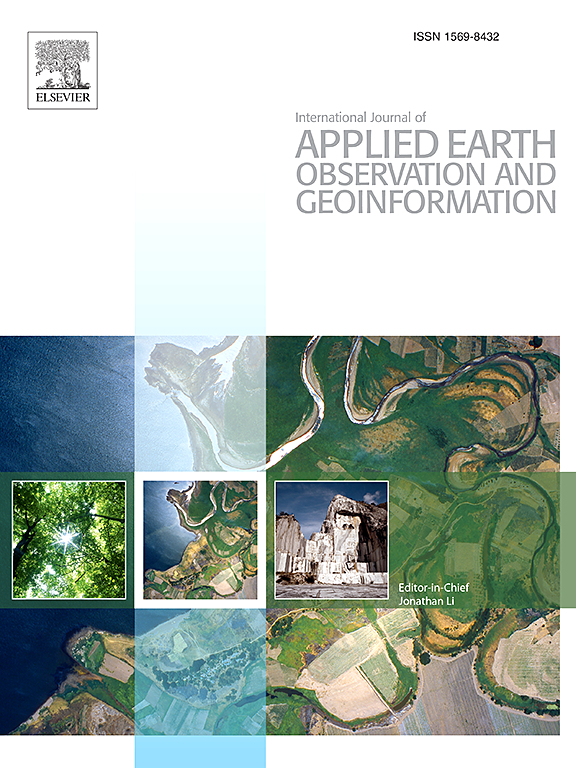高度城市化地区的栖息地破碎化评估:减轻景观剥离和栖息地恢复的意义
IF 7.6
Q1 REMOTE SENSING
International journal of applied earth observation and geoinformation : ITC journal
Pub Date : 2025-04-23
DOI:10.1016/j.jag.2025.104557
引用次数: 0
摘要
有效测量和监测栖息地破碎化对于实现联合国可持续发展目标至关重要,特别是考虑到全球城市化的持续扩张。然而,目前的研究主要是将栖息地连通性或景观解剖分开研究,而忽视了景观解剖对栖息地格局的影响。在本研究中,我们采用路网块(RNTs)作为分析单元,并开发了有效栖息地网络面积的综合指数来评估栖息地破碎化(结构连通性),特别强调景观解剖。此外,还提出了一个连接效率指标来量化当前栖息地连通性与其最大潜力的比率。综合解释这些指数既反映了道路扩张对生境格局的不利影响,也反映了空间规划中缓解措施的有效性。这些指标应用于中国京津冀(BTH)地区。结果表明:2007 - 2018年,北京地区生境网络的有效面积从887.66 km2下降至488.50 km2,但总体上生境总面积有所增加;然而,BTH地区大多数城市的连通性效率有所提高,这表明2018年的栖息地连通性比2007年更有效,更接近其最大值,这可能是由于有效的景观管理措施。通过将城市渗透纳入与rnt的联合分析,可以确定生境保护和恢复的关键区域。该研究提供了一种新的、有效的栖息地破碎化量化方法,为减轻城市化对栖息地格局的负面影响提供了有价值的决策见解。本文章由计算机程序翻译,如有差异,请以英文原文为准。
Assessing habitat fragmentation in highly urbanized area: Implications for mitigating landscape dissection and habitat restoration
Effective measurement and monitoring of habitat fragmentation are essential for achieving the United Nations’ Sustainable Development Goals, especially given the ongoing global expansion of urbanization. However, current researches primarily address habitat connectivity or landscape dissection separately, while neglecting the impact of landscape dissection on habitat pattern. In this study, we adopt Road network tiles (RNTs, created through the dissection of the landscape by road networks) as analytical units and develop an integrated index of effective habitat network area to assess habitat fragmentation (structural connectivity), with particular emphasis on landscape dissection. Furthermore, a connection efficiency index is proposed to quantify the ratio of current habitat connectivity to its maximum potential. Collectively interpreting these indices reflects both the adverse effects of road expansion on habitat patterns and the effectiveness of mitigation efforts in spatial planning. These indices were applied to the Beijing-Tianjin-Hebei (BTH) region of China. The results show that the effective area of habitat networks in the BTH region declined from 887.66 km2 to 488.50 km2 from 2007 to 2018, despite an overall increase in total habitat area. Nevertheless, connection efficiency for most cities in the BTH region has improved, suggesting that habitat connectivity in 2018 was more efficient and closer to its maximum value compared to 2007, potentially due to effective landscape management practices. By incorporating urban permeation into the joint analysis with RNTs, key zones for habitat conservation and restoration can be identified. This study offers a novel and efficient approach to quantifying habitat fragmentation, providing valuable insights for decision-making aimed at mitigating the negative impacts of urbanization on habitat pattern.
求助全文
通过发布文献求助,成功后即可免费获取论文全文。
去求助
来源期刊

International journal of applied earth observation and geoinformation : ITC journal
Global and Planetary Change, Management, Monitoring, Policy and Law, Earth-Surface Processes, Computers in Earth Sciences
CiteScore
12.00
自引率
0.00%
发文量
0
审稿时长
77 days
期刊介绍:
The International Journal of Applied Earth Observation and Geoinformation publishes original papers that utilize earth observation data for natural resource and environmental inventory and management. These data primarily originate from remote sensing platforms, including satellites and aircraft, supplemented by surface and subsurface measurements. Addressing natural resources such as forests, agricultural land, soils, and water, as well as environmental concerns like biodiversity, land degradation, and hazards, the journal explores conceptual and data-driven approaches. It covers geoinformation themes like capturing, databasing, visualization, interpretation, data quality, and spatial uncertainty.
 求助内容:
求助内容: 应助结果提醒方式:
应助结果提醒方式:


